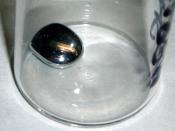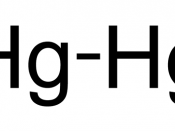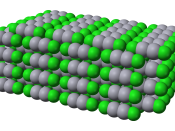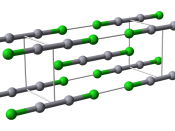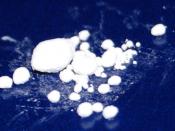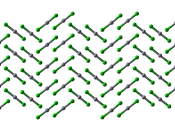Mercury The element mercury or Hg is an extremely heavy metal and is the only metal that is a liquid at room temperature. Often called quicksilver due to its silvery- white color mercury was named after the planet mercury. Although it's a good conductor of electricity mercury is a poor conductor of heat and its a fairly unreactive metal and is also highly resistant to corrosion. Mercury's name derived from the Latin word Hydragyrum or liquid silver. The discoverer of mercury is unknown but it is a known fact that mercury was well known to the Chinese and samples of the element have been found in Egypt that date back to 1500b.c. . Mercury is rarely found as a pure metal in nature, but its chief ore cinnabar or vermilion which is a bright red metal that is made up of mercury sulfide & is mainly found in Italy and in Spain where there are mercury mines that have been operating for over 2,000 years.
Metallic mercury is recovered from the cinnabar by heating it in air and condensing the mercury vapor. Mercury melts at ""38.87 degrees Celsius and boils at ""356.58 degrees Celsius. Washing it with nitric acid followed by distillation can purify Mercury. Mercury is sold and traded in the world markets in units called "flasks" 1 flask is equal to 76 pounds. Some of the commercial uses of mercury include thermometers, barometers, fluorescent lamps, electrical switches and batteries. Mercury is highly suitable for thermometers because it doesn't moisten the glass and thermal expansion is uniform. At 239k the density of mercury is 13.456 g/cm3. A compound of mercury called mercuric nitrate was once used in the manufacturing process of felt hats and workers that came in contact with it developed serious heath problems like the loss of hair, teeth and memory and deterioration of their nervous system. Mercury batteries consist of zinc anode and a mercuric oxide called cathode and the batteries develop about 4.35 volts. In many early civilizations mercury was used to fight away evil spirits and the Greeks used it for medicine. The 2 most useful mercury salts are both of the mercury chlorides and mercury sulfide. Mercurus chloride or calomel is a white relatively soluble salt that is used in calomel electrodes, which are used in Electro chemistry. Calomel is used in medicines as a cathartic and diuretic. When calomel is used in teething powder for children it can actually poison them. Mercuric chloride or corrosive sublimate is highly poisonous because it is so soluble and was used for deliberate poisonings as early as the 14th century. Mercuric chloride is also used as a disinfectant for preparing other mercury compounds and in anti-fungal skin ointments. Mercuric sulfide occurs in a red form and an amorphous black form. There are 2 types of mercury poisoning that exist: acute and chronic. Acute mercury poisoning results from ingestion of a soluble mercury salt, which can violently corrode the skin and mucus membranes. If mercury vapor is breathed into the lungs it can cause severe pneumonia or death. Chronic mercury poisoning occurs through regular absorption of small amounts of mercury which is often a problem for the workers in mercury mines and industries that use mercury. When mercury salts are released into the environment frequently it may be converted by anaerobic bacteria into such compounds that are then carried through the food chain to humans like at the disaster at Manama Bay, Japan.
